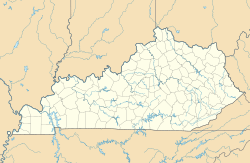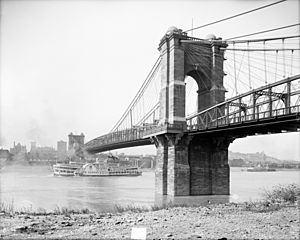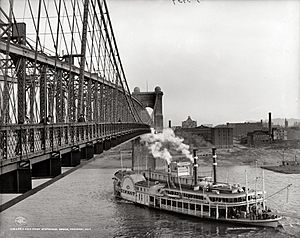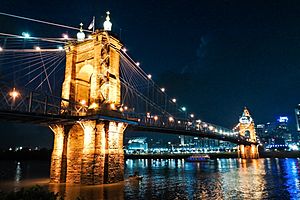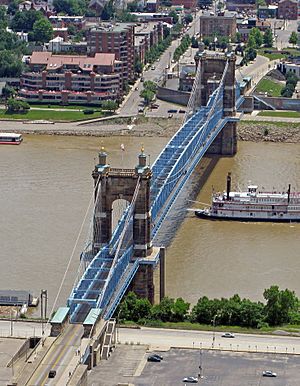John A. Roebling Suspension Bridge facts for kids
Quick facts for kids John A. Roebling Suspension Bridge |
|
|---|---|
| Carries | |
| Crosses | Ohio River |
| Other name(s) | Covington and Cincinnati Suspension Bridge |
| Characteristics | |
| Total length | 1,642 ft 11 in (500.8 m) |
| Longest span | 1,057 ft (322 m) |
| Clearance below | 100 ft (30 m) |
|
Covington and Cincinnati Suspension Bridge
|
|
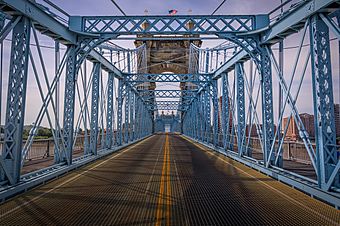
A view of the John A. Roebling Suspension Bridge from Cincinnati, Ohio on the north bank of the Ohio River with Covington, Kentucky in the background
|
|
| Location | Cincinnati, Ohio to Covington, Kentucky |
|---|---|
| Built | 1856—1867 |
| Architect | John A. Roebling |
| NRHP reference No. | 75000786 |
| Significant dates | |
| Added to NRHP | May 15, 1975 |
| Designated NHL | May 15, 1975 |
The John A. Roebling Suspension Bridge connects Cincinnati, Ohio, and Covington, Kentucky, across the Ohio River. When it opened on December 1, 1866, its main section was 1,057 feet (322 m) long. This made it the longest suspension bridge in the world at that time!
Later, in 1883, John A. Roebling designed an even longer bridge: the famous Brooklyn Bridge. Today, people still walk across the Roebling Bridge. They use it to get between sports stadiums in Cincinnati and the hotels, restaurants, and parking areas in Northern Kentucky. The area near the bridge on the Kentucky side is called Roebling Point.
Long ago, special ramps led from the bridge to the Dixie Terminal building. This building was used for streetcars. The ramps allowed streetcars to travel easily between Covington and Cincinnati. When streetcar service stopped in the 1950s, the terminal became a bus station. The ramps were removed in 1998 when it was no longer used for buses.
Contents
Planning the Bridge: A Big Idea
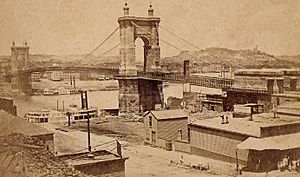
In the mid-1800s, people really needed a way to cross the Ohio River. So much trade was happening between Ohio and Kentucky that busy steamboat traffic was slowing down business. A new bridge was needed, but it couldn't block the river.
Engineers in France had developed a new type of bridge called a wire cable suspension bridge. Some American engineers, like John A. Roebling from Saxonburg, Pennsylvania, started designing these bridges too. The Ohio River was much wider than any river that had been bridged in France. This made the project a huge challenge.
Starting the Bridge Company
In February 1846, a company called the Covington and Cincinnati Bridge Company was formed. They asked Roebling to design a bridge. His first idea was for a bridge 1,200-foot (370 m) long. It would have 100 feet (30 m) of space below it for steamboats to pass. But it also included a huge tower in the middle of the river.
Steamboat owners and ferry operators did not like this plan. They worried the tower would block the river. They also feared losing their ferry business. Because of their concerns, the Ohio government refused to approve the bridge.
In September, Roebling wrote a 36-page report. He explained the technical details and answered the problems people had. He argued that steamboat chimneys were too tall and talked about how important it was to bridge western rivers. Still, the government did not approve the bridge.
Later, after seeing a suspension bridge built upriver in Wheeling, West Virginia, the government changed its mind. They approved the bridge but demanded a very long main section of 1,400 feet (430 m). They also insisted on choosing the bridge's location. This decision caused problems later on.
The roads in Cincinnati and Covington were lined up perfectly for a bridge. But the Ohio government chose a different spot. This meant the bridge was almost entirely in Kentucky. Cincinnati lost the chance to have "one of the finest and most magnificent avenues on this continent."
In 1854, a small suspension bridge over the Licking River in Newport, Kentucky, fell down. This made investors nervous, and the bridge company couldn't raise enough money to start building.
In 1856, Amos Shinkle joined the company's board. He brought new energy and quickly found private investors. He also got more support from both the Ohio and Kentucky governments. The bridge plan was changed, and the main section was shortened to at least 1,000 feet (300 m). Roebling was now well-known. The company president traveled to Iowa to meet Roebling and sign a contract to build the bridge. Roebling arrived in Cincinnati in September, but nothing was ready for construction.
Building the Bridge: A Long Journey
Building the foundation for the Covington tower began in September 1856 and went smoothly. They laid 13 layers of oak beams, crisscrossing them and bolting them together. Then, they cemented everything in place.
On the Cincinnati side, work was delayed from the start. Workers couldn't pump water out of the digging pit fast enough. After months of slow progress, Roebling decided to build his own pumps. He made square pumps from three-inch pine planks in about two days. He ran them using one of Amos Shinkle's tugboats. These homemade pumps moved a lot of mud and clay!
Foundations and Early Delays
When the crews reached the hard gravel bed of the Ohio River, Roebling decided it was strong enough for the Cincinnati tower's foundation. They laid oak timbers, just like on the Covington side. Within three months, the stone towers rose above the water. Work stopped for the winter because of freezing temperatures and high water levels. This seasonal stopping continued until the bridge was finished. A new contract was made, saying the bridge should be done by December 1858, unless "unavoidable calamities" happened.
After a tough winter in 1856–57 and a wet spring, construction started again in July 1857. They used sandstone for the first 25 feet of each tower base. Limestone covered this sandstone to protect it from water damage and boat collisions. The rest of the towers were built with rough-cut sandstone. Roebling said this gave the towers a "massive look," which suited their purpose.
From July to August 1857, the company ran out of money. This problem got worse because of a financial crisis called the Panic of 1857. Work stopped because they couldn't pay for the project. In July 1858, work started again, but with fewer workers. Only one tower was worked on at a time. The company president died, and no work was done in 1859 or 1860.
Civil War and Renewed Efforts
In November 1860, Abraham Lincoln became president, and the Civil War began in January 1861. When Confederate forces threatened Cincinnati, a temporary pontoon bridge was built. This allowed Union troops to cross the Ohio River and build defenses.
Soon after, it became clear that a permanent bridge was very important. Money from investors started pouring in. Bonds were sold, and in January 1863, building materials began to arrive. To build faster, the required height of the main section was lowered to 100 feet (30 m). Preparations to restart construction were made. New machinery was ordered, but another threat of invasion stopped progress again for a short time. Finally, in the spring of 1863, work began and continued until the end of the year.
In the spring of 1864, work resumed. Roebling had his own wire factory, but the bridge company bought one million pounds of wire from England. Roebling preferred this wire because it was stronger and better quality than wire made in the United States.
Anchorages (strong foundations that hold the cables) were built on both sides of the river. They had a limestone base and a special stone finish. Huge 11-ton iron anchors were set into each block. These anchors held the cables with strong iron chain links designed by Roebling. The Civil War made it hard to find enough workers, which slowed down the project until the war ended.
Finishing Touches and Opening Day
Work on the bridge moved steadily after the war. In September 1865, the first two wire ropes were put in place. They were unrolled from a boat, sunk to the river bottom, and then lifted up together. Wooden crossbeams were laid at regular spaces on the wire ropes. A simple walkway was built for the workers. With the Ohio River "spanned," there was a final push to finish the project, even through floods and freezing weather.
The cabling of the bridge happened very quickly, with about 80 wires placed each day. Hundreds of people watched this amazing process from both sides of the river. On June 23, 1866, the last wire was brought across. In total, 10,360 wires were used! These wires were then pressed together and wrapped with an outer layer of wire, forming two main cables, each with 5,180 wires.
By the end of August, suspenders (vertical cables) were hung from the main cables. Then, 600,000 feet (180,000 m) of oak wood was laid as the bridge floor, supported by 300 wrought iron beams. Two tracks for streetcars were also added. Diagonal stays (extra supports) were put in to help the bridge carry more weight, strengthen the floor, and reduce shaking. Wrought iron trusses (support structures) were added along the length of the bridge.
On December 1, 1866, people walked on the bridge for the very first time. It was known locally as "The Suspension Bridge." Over 166,000 people crossed it in the first two days! The final details were added over the next few months, and construction officially ended in July 1867. Sadly, two men died during the construction.
When the Roebling Bridge officially opened on January 1, 1867, there was a toll to cross. A horse and buggy cost 15 cents, and three horses with a carriage cost 25 cents. People walking across paid one cent.
Changes and Special Honors

The bridge's original deck (the road surface) was built as cheaply as possible because of high prices during the Civil War. However, the stone towers were designed to hold a much heavier load. In 1896, the bridge got new main cables, a wider steel deck, and a longer northern approach. These changes made the bridge look different, but they also allowed it to carry heavier loads (up to 30 tons). This helped the bridge stay useful for many more years. In 1976, for America's 200th birthday, the bridge was painted blue instead of brown.
The Covington-Cincinnati Bridge Company, a private business, ran the bridge until the state of Kentucky bought it in 1953 for $4.2 million. The state collected tolls until 1963. That's when the Brent Spence Bridge opened nearby, about 0.6 miles (0.97 km) west of the Roebling Bridge.
The bridge received special honors:
- In 1975, it was named a National Historic Landmark.
- In 1983, it was named a National Historic Civil Engineering Landmark.
The Roebling Bridge is still the busiest bridge in Cincinnati for cars and people, besides the big highway bridges. It was first called the "Covington-Cincinnati Suspension Bridge." On June 27, 1983, it was renamed the "John A. Roebling Suspension Bridge" to honor its designer and builder.
Bridge Closures for Repairs
The state of Kentucky closed the bridge on November 13, 2006, for major repairs. It reopened in late March 2007. However, it closed again for most of 2008 to be repainted. On September 11, 2007, the weight limit was lowered to 11 tons. This was done to prevent future damage after a study by the University of Kentucky. The lower weight limit means buses cannot cross the bridge.
The bridge closed again on April 7, 2010, for a complete repainting. It reopened in November 2010. During this time, only cars were affected; one pedestrian lane remained open.
Other Times the Bridge Was Closed
On January 10, 2013, a large piece of sandstone fell from the north tower. This caused the bridge to close for about four hours during rush hour. Workers removed the debris and checked the tower for more damage.
On March 21, 2018, a car accident damaged a steel part of the bridge that was built in 1890. The bridge reopened in April 2018.
On November 11, 2020, the Brent Spence Bridge closed after a fiery crash. Large trucks started using the Roebling Bridge as an alternate route, even though it was against the 11-ton weight limit. That night, Covington police closed the Roebling Bridge to all vehicles. They wanted to put extra safety measures in place. The Roebling Bridge reopened on November 13, 2020, with police from Covington and Cincinnati watching traffic on the bridge.
Images for kids
See also
 In Spanish: Puente colgante John A. Roebling para niños
In Spanish: Puente colgante John A. Roebling para niños


